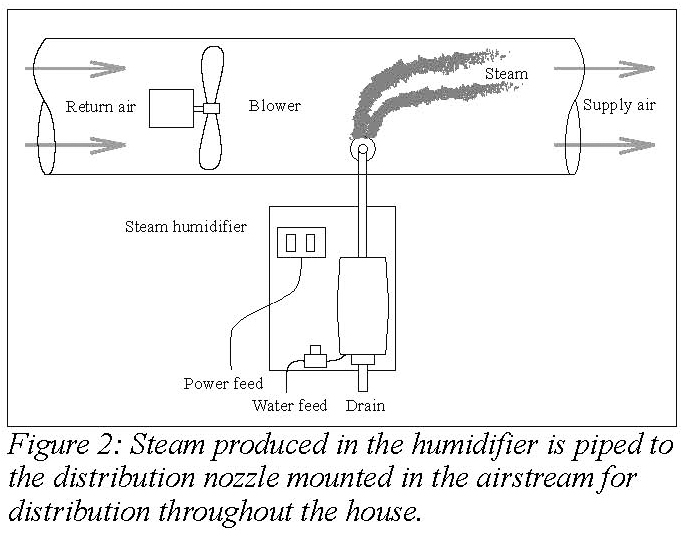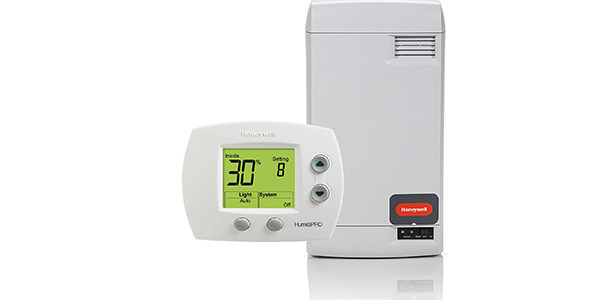Humidification of Residences in Cold Climates
Heat and Moisture Loss
The air in our homes is in constant motion-moving between indoors and outdoors due to infiltration. During the winter, the total volume of heated air in a typical house is exchanged an average of once every 20 to 60 minutes with fresh air from outdoors. The warm moist indoor air escapes through crevices around windows, doors, vent pipes, exhaust fans, ductwork, recessed lights, and cracks in the home’s envelope. As the warm moist air escapes it is replaced with the colder and drier winter outdoor air. This exchange of air results in the loss of heat and moisture from the house to the outdoor environment. The lost heat is replaced by the central heating system with some additional help from the heat of lights and appliances. The lost moisture is partially replaced by the activities of the home’s inhabitants through breathing, cooking and bathing. To more completely replace the lost moisture the house must be equipped with a humidifier. For example, in figure 1: The air temperature in the house is 72° F and the air temperature outside is 30°F at a relative humidity (RH) of 40%. As the colder and drier air from outdoors replaces the warm moist air escaping from the house, the humidity level in the house drops. If no additional moisture is added, the humidity level will drop to an average of about 9% RH.
For example, in figure 1: The air temperature in the house is 72° F and the air temperature outside is 30°F at a relative humidity (RH) of 40%. As the colder and drier air from outdoors replaces the warm moist air escaping from the house, the humidity level in the house drops. If no additional moisture is added, the humidity level will drop to an average of about 9% RH.
Central Humidification
Like the heating needs of the house, the need for adding moisture is greater when the outdoor air temperature is lower. Calculating the capacity of the humidification system for a house is a relatively straight forward calculation based on the size of the house, how well the house was built, the infiltration rate, and how cold it gets in that geographical region. Humidifiers can be purchased in a variety of types and capacities. Steam units are typically used for central humidification systems in homes. Steam humidifiers are effective because they produce a large volume of moisture in a compact unit and operate on their own power source.
The air in our homes is in constant motion-moving between indoors and outdoors due to infiltration. During the winter, the total volume of heated air in a typical house is exchanged an average of once every 20 to 60 minutes with fresh air from outdoors. The warm moist indoor air escapes through crevices around windows, doors, vent pipes, exhaust fans, ductwork, recessed lights, and cracks in the home’s envelope. As the warm moist air escapes it is replaced with the colder and drier winter outdoor air. This exchange of air results in the loss of heat and moisture from the house to the outdoor environment. The lost heat is replaced by the central heating system with some additional help from the heat of lights and appliances. The lost moisture is partially replaced by the activities of the home’s inhabitants through breathing, cooking and bathing. To more completely replace the lost moisture the house must be equipped with a humidifier.
 For example, in figure 1: The air temperature in the house is 72° F and the air temperature outside is 30°F at a relative humidity (RH) of 40%. As the colder and drier air from outdoors replaces the warm moist air escaping from the house, the humidity level in the house drops. If no additional moisture is added, the humidity level will drop to an average of about 9% RH.
For example, in figure 1: The air temperature in the house is 72° F and the air temperature outside is 30°F at a relative humidity (RH) of 40%. As the colder and drier air from outdoors replaces the warm moist air escaping from the house, the humidity level in the house drops. If no additional moisture is added, the humidity level will drop to an average of about 9% RH.Humidity Settings and Performance
As the humidity levels in the house rise there is an increase in stress on the exterior walls, windows, and doors because the higher level of moisture in the house wants to equalize with the cold and dry outdoor environment. This stress is increased when the outdoor air temperature drops. Most homes can handle a relative humidity level between 25% and 35% on a typical winter day. On very cold days a lower humidity level will be required. For example, when the temperature is in the teens and single digits condensation is likely to form at humidity levels much above 20% RH. Determining the set point of the humidification system of a particular house takes some trial and error. The maximum setting is ultimately determined when condensation forms at the weakest point in the house’s envelope-typically at a window or door. Once signs of moisture are observed, the set point of the humidification system must be lowered to prevent further condensation. Finding a single ideal humidity level that satisfies both personal comfort and the home’s structural capacity is difficult or impossible. Ultimately there needs to be a compromise in the humidity level between what the occupants desire and what the building can handle without damage to the structure.


Comments are closed.